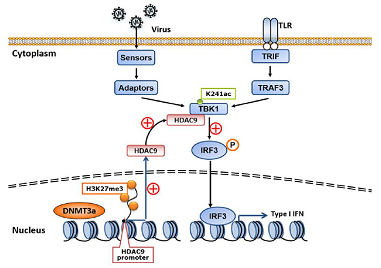Prof. Xuetao Cao’s and Qingqing Wang's groups reported methyltransferase Dnmt3a regulates antiviral innate immunity in Nat Immunol
Source:Qingqing Wang
2016-07-11
Research team led by Prof. Xuetao Cao (Academician, Chinese Academy of Engineering) and Prof. Qingqing Wang (Zhejiang University School of Medicine) reported a novel function of DNA methyltransferase Dnmt3a in antiviral immune responses. This study was recently published at Nature Immunology (Li X, et al. Methyltransferase Dnmt3a upregulates HDAC9 to deacetylate the kinase TBK1 for activation of antiviral innate immunity. 2016 July;17(7):806-15).
Their findings provide new insight into how a chromatin regulator such as DNA methyltransferase Dnmt3a can influence TBK1 activation and antiviral responses.The DNA methyltransferase Dnmt3a has high expression in terminally differentiated macrophages; however, its role in innate immunity remains unknown. This study reported that deficiency in Dnmt3a selectively impaired the production of type I interferons triggered by pattern-recognition receptors (PRRs), but not that of the proinflammatory cytokines TNF and IL-6. Dnmt3a-deficient mice exhibited enhanced susceptibility to viral challenge. Dnmt3a did not directly regulate the transcription of genes encoding type I interferons; instead, it increased the production of type I interferons through an epigenetic mechanism by maintaining high expression of the histone deacetylase HDAC9. In turn, HDAC9 directly maintained the deacetylation status of the key PRR signaling molecule TBK1 and enhanced its kinase activity. These data add mechanistic insight into the crosstalk between epigenetic modifications and post-translational modifications in the regulation of PRR signaling and activation of antiviral innate immune responses.

Their findings provide new insight into how a chromatin regulator such as DNA methyltransferase Dnmt3a can influence TBK1 activation and antiviral responses.The DNA methyltransferase Dnmt3a has high expression in terminally differentiated macrophages; however, its role in innate immunity remains unknown. This study reported that deficiency in Dnmt3a selectively impaired the production of type I interferons triggered by pattern-recognition receptors (PRRs), but not that of the proinflammatory cytokines TNF and IL-6. Dnmt3a-deficient mice exhibited enhanced susceptibility to viral challenge. Dnmt3a did not directly regulate the transcription of genes encoding type I interferons; instead, it increased the production of type I interferons through an epigenetic mechanism by maintaining high expression of the histone deacetylase HDAC9. In turn, HDAC9 directly maintained the deacetylation status of the key PRR signaling molecule TBK1 and enhanced its kinase activity. These data add mechanistic insight into the crosstalk between epigenetic modifications and post-translational modifications in the regulation of PRR signaling and activation of antiviral innate immune responses.

Dnmt3a enhanced the TLR3-, TLR4- or virus-induced production of type I interferons by increasing the kinase activity of TBK1 through upregulating transcription of the gene encoding HDAC9 and promoting HDAC9-mediated deacetylation of TBK1 (Li X, et al.Nat Immunol. 2016;17(7):806-15. doi: 10.1038/ni.3464)


